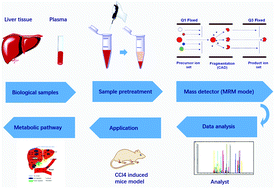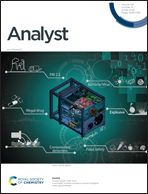A high-throughput targeted metabolomics method for the quantification of 104 non-polar metabolites in cholesterol, eicosanoid, and phospholipid metabolism: application in the study of a CCl4-induced liver injury mouse model†
Abstract
Much evidence suggested that cholesterol, eicosanoid and phospholipid metabolism plays crucial roles in inflammation, atherosclerosis, carcinogenesis, etc. Therefore, fast and accurate quantification of the metabolites in these metabolic pathways is necessary for discovering the molecular mechanisms and biomarkers of related diseases. In this assay, ultra-high performance liquid chromatography combined with triple quadrupole mass spectrometry platform (UPLC-QqQ-MS) based protocols were developed to simultaneously quantify a total of 104 key metabolites including 32 phospholipids (PLs), 44 eicosanoids (EAs), 28 oxysterols and bile acids (BAs), within 15 minutes. Validation results showed that this method is stable, sensitive and accurate for analyzing different matrix samples. Next, this method was used to characterize the metabolic phenotype of a CCl4-induced liver injury model. The results showed that polyunsaturated fatty acids (PUFA) and PUFA acyl-phospholipids (PFA-PLs) were down-regulated and the levels of saturated fatty acyl-phospholipids (SFA-PLs) and EAs were up-regulated in both the liver tissue and plasma of the CCl4-injury group. BAs were up-regulated in plasma, but down-regulated in the liver tissue of the CCl4-injury group. Immunohistochemistry assay demonstrated that the expression levels of cytosolic phospholipase A2 (cPLA2), phosphorylated cytosolic phospholipase A2 (p-cPLA2), secreted phospholipase A2-IIA (sPLA2-IIA) and lysophosphatidylcholine acyltransferase 1 (LPCAT1) were all up-regulated. According to our results, we drew a diagram of the CCl4-induced acute liver injury molecular mechanism. Moreover, we found that the area under the receiver operating characteristic curve (AUC) of 7α-hydroxycholesterol and 7β-hydroxycholesterol was 1.0, which indicates that the two metabolites have significant potential for the diagnosis of acute liver injury. The outstanding performance of this analytical method proves its further usefulness for mechanism studies and biomarker screening of related diseases.



 Please wait while we load your content...
Please wait while we load your content...